Vice President's Corner
How many BAWA Days does it take to build a rear stairs? This year marks something around 20 years of BAWA participating with the Rebuilding Together non-profit performing construction for the needy either in San Francisco or the Peninsula.
This year we were assigned what on the face of it is a straightforward exterior wooden stair replacement in Daly City. However, the old rotted stairs first needed to be demolished and removed. However this site did not have a side yard so everything at this year's project had to be carted through the house down a flight of stairs -- everything!
Dan Goodman and Frank Taylor designed the new stairs both with drawing tools and pencil (the submitted drawings) and a SketchUp version. They obtained a building permit hours before Preparation Day #1, April 14th, following multiple days work to get that permit. Demolition Day was aided by Project 90 volunteers who set up scaffolding and demolished the wood structures by lunch time and then proceeded to break up concrete and dug a foot down for the forms.. John Hickman and a small crew from Cal Water plus Dan, Frank and myself staffed Prep Day #2. Just three of us managed the concrete pour on the following Tuesday after a successful building inspection the day before. Frank and Dan started putting in week-day volunteering and removed the concrete forms and backfilled enough dirt to make the site safer for the big day on April 28th when at least 16 BAWA volunteers put in a full day and enjoyed some traditional Puerto Rican cooking by the homeowner, Frank LaFontaine, and his wife and son. The major structural work was accomplished using a 'shop' set up in the front yard. There many parts were cut including some, which were not installed that day as sunset came before the project could be completed.
But it doesn't stop there as Dan and Frank have been on site all week (as I write this on May 2nd) and will be there each day until Cinco de Mayo this Saturday when hopefully the project will be wrapped up. Meanwhile Phillip Chang showed up for his first BAWA meeting on April 19th and has already volunteered two Saturdays and will be there one more this Saturday. I sure hope he enjoys some BAWA meetings in coming months. Dan and Frank will have put in over a dozen days each and the good news is that the project is looking good, the food has been tasty and plentiful this year plus the homeowners have been ideal and well liked by Club members. Also, passing through the house is not as hard on the nasal passages as a certain well-remembered rodent-infested project a few years ago.
Personally I am continually impressed with the great selection of tools which BAWA members pull from their trucks, vans, and trunks. Then when given assignments on Volunteer Days, proceed to exhibit skills in many aspects of construction using all those tools. I mean there is no requirement that folks have construction skills when joining our club, but many seem to have them. OK, there is a close relationship between construction and furniture making and cabinet making, luckily for the homeowner recipients of our work each April. Rebuilding Together Peninsula took on 65 sites this year and I am proud that our hobby club was able to take on one of them and as this discussion has revealed, not a simple or easy job requiring many BAWA days to return multiple times to solve the riddle. Thanks BAWA volunteers....check in next year. Watch for photos of the BAWA MMXII plaque which Frank facilitated getting cast in the base of one post on site this year.
Thanks all.
Jay Perrine -- Vice President
perrinedazign@gmail.com
Jay Perrine called the meeting to order and asked guests and new members to introduce themselves:
Allen: His current project is to make a chicken coop and he recently purchased a table saw.
John Kaplan: He began woodworking 25 years ago and recently finished making a finger joint box and a wooden clock.
Phillip Chang: He just graduated from college with a degree in architecture.
Paul Larson: He is retired and likes furniture restoration.
Announcements:
Per Madsen: Per reviewed the upcoming BAWA events and meetings.
April 28 - Rebuilding Together Peninsula
May 15 - Bill Henzel will talk about his home renovation at the Facebook woodshop on Page Mill Road
June 21 - John Economaki from BridgeCity Toolworks
July - open
Aug - open
Sept - open
Oct - Third Annual BAWA Woodshow
Fred Reicher: A woodworker has contacted Fred to help sell a wooden carrousel horse. It is in pieces and requires some carving to restore it. The owner paid $1,000 for it. Another person is looking for someone to cane a wicker chair. Contact Fred if you are interested in either item.
Dan Goodman: The Rebuilding Together Peninsula project is scheduled for Saturday, April 28. The project is to rebuild an exterior staircase. The demolition has already been performed and the foundation work will be done on April 21. Frank Taylor is the project foreman.
Yeung Chan: Yeung will be participating in a show called "Woodworking in America" on October 12-14 to be held in Pasadena, CA. Other participants will include Paul Schurch and Roy Underhill.
Eric McCrystal: Eric said that Woodcraft San Carlos will be sending two of its staff to the new Facebook woodshop and he is therefore looking to hire two new employees. He showed us a laser cut plaque that will identify the plywood furniture that is contributed by woodworkers. BAWA members working on furniture for Facebook are reminded that their pieces are needed by the May 15 BAWA meeting.
Steve Rosenblum: The plane class held last weekend was a resounding success. Eighteen people attended the class. The morning session included a series of lectures by the four instructors. Topics included rebuilding a plane, how to buy a plane, hand plane techniques and types of planes. In the afternoon practical workshop everyone got to practice what had been learned.
Scott Wynn Furniture Design and Development
Scott is an architect, designer and woodworker. He has had a professional woodshop since 1976 and previously presented to BAWA on the topic of hand planes. His book, Woodworkers Guide to Handplanes, is a classic. His shop is located in the Bayview district of San Francisco, 17th and Yosemite.
Scott's presentation featured a slideshow of many of his pieces of work. In 1974 he did a series of carvings for a restaurant in Hawaii, then he did the interior of a lawyer's yacht that featured a carved dolphin. In the 1980s Scott worked on the restoration of a Victorian house in San Francisco that had been built in 1884. He designed, made and installed all of the exterior redwood moldings and pilasters.
A client in Berkeley commissioned a massive project that would take Scott 2 1/2 years to complete. It featured a living room with elaborate mahogany woodworking, arches and carvings. Everything was built offsite then transported to the house and installed. For the bedroom suite, Scott built a wardrobe, end tables, jewelry cabinet, bed, and bench. All the pieces were made of ash.
Other projects shown included a Shaker wardrobe and matching nightstands, a 12' long dining room table with two extension leaves, a drop leaf table, and a valet chair made of ash and dyed with aniline dyes in red and black.
His recent works reflect a recessionary mood: an anti-café chair and stools featuring hidden bridle joints and aluminum stretchers.
He did a complete kitchen for a client that features a concrete splash panel and with cabinets made of maple, wenge and oak. He made the doors, shoji screens, a 14' bench and 2 shelving units. The entry hall table featured drawers and a blued steel end cap.
He made a jewelry chest of claro walnut that suggest a kimono design. The interior has full extension shelves and is made of paduk and pear wood.
A shoji screen features water and leaves with a curved top transom.
An entertainment cabinet, made of vertical grain hemlock has a tapered shape, 10' long and features an ice pattern, tear-drop pulls and wooden grill work.
Scott showed us several photographs of his most recent work, a display cabinet he has made to show at the American Crafts Council meeting to be held Aug 3-5 at Fort Mason in San Francisco. The cabinet is made of solid quarter sawn cherry, hemlock and clear maple. It features opposing triangular doors that incorporate multiple radiating rays of maple that wrap around to the side of the cabinet. The rays meet at the corner to form a valley, but when the doors are opened, the rays become a continuous curve. This cabinet took Scott a little over 120 hours to build and will be offered for sale in a price range of $9,000.
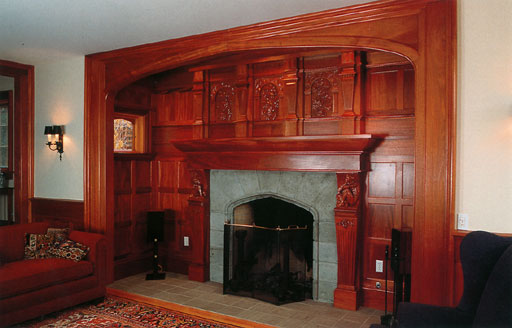



It was an extraordinary slide presentation. Scott's work is remarkable, especially his latest cabinet. BAWA is honored to be the first to see it. We thank you, Scott for showing us this fine collection of your work.
Dan Goodman: A Spiked Chair for Facebook
Dan took 1 1/2 sheets of plywood and cut it into several strips 3/4" x 1 in various lengths for a total of 255 sticks and 255 spacers. He designed the chair on SketchUp. The strips were mounted vertically so that the lengths created a shaped bowl into which a person could sit. The chair seat was surprisingly comfortable, although the back could have offered better support.
Tom Gaston:
Tom showed us bowl he turned from a block of green acacia he had retrieved from a tree cut down by an arborist. He also showed us a mahogany coffee table he made for his college bound daughter. It features breadboard ends and he counter sunk the leg skid pads as Arnold Champagne had recommended at an earlier meeting.
Claude Godcharles:
Claude has been helping to launch the "Work Magazine Reprint" project. The publication Work first appeared 123 years ago. This new project will republish old issues of work with comments from the blogosphere. It can be found on the website: toolsforwoodworking.com
John Blackmore
JohnBlackmore@comcast.netThe BAWA Handplaning Workshop, April 7th 2012, Palo Alto High School Woodshop
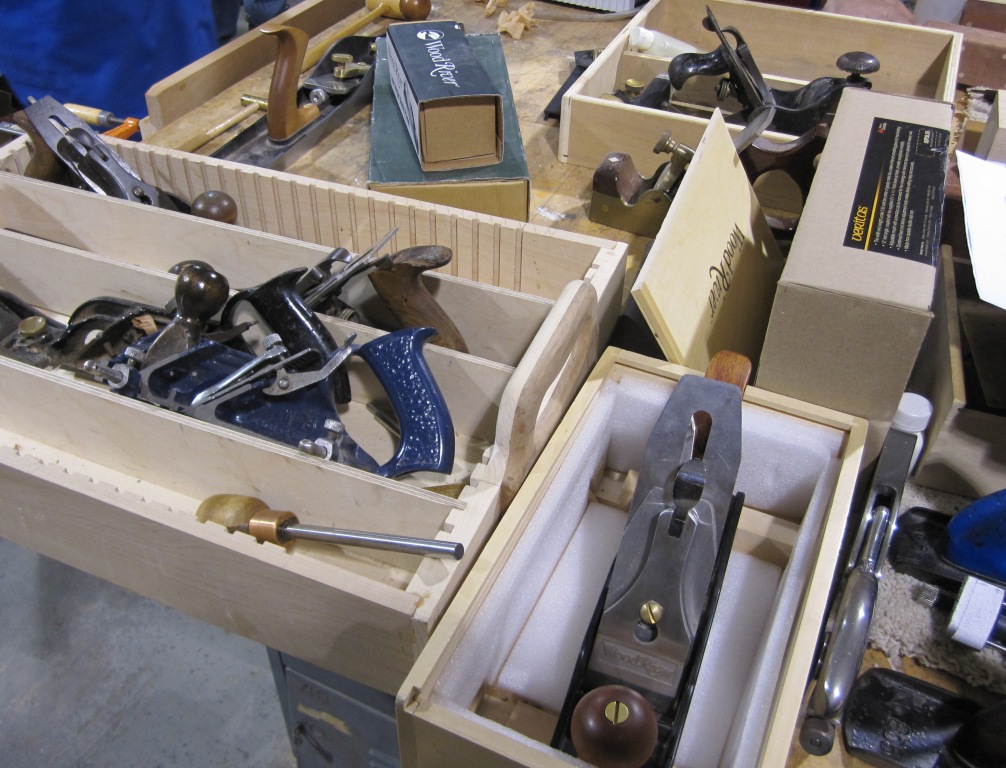
The day was beautiful and sunny but 19 eager woodworkers showed up in Palo Alto to spend the day indoors and to learn about the tuning and use of handplanes from 4 club member experts, Harold Patterson, Neal White, Yeung Chan and Don Naples. The common message from all of them was that a sharp plane blade could make up for many errors of plane setup and user technique. The students consisted of 8 BAWA members and 11 students from the Palo Alto Adult Education Woodworking classes, mainly those taught by Marcus Miller. These students were enthusiastic about the program and we hope that some of them will attend future BAWA meetings and join our group.

Harold Patterson

Neal White
After an introduction by Per Madsen, Harold kicked off the session by describing the main types of handplanes. The length of the sole determines the use, with the 21 inch long jointer plane used for flattening boards the 10 inch smoothing plane for smoothing boards and the small block plane, which is used in high blade angle and low blade angle configurations, for smoothing small areas. Tuning the plane begins with flattening the sole on a series of increasingly finer sandpaper attached to a flat granite or glass slab. Then the frog is flattened and smoothed after which the back of the blade is flattened and polished followed by the forming of the bevel on the front of the blade. Harold recommended the Woodriver bench planes from Woodcraft as a good bench plane for a beginning woodworker with a quality commensurate with their moderate prices.
The next speaker was Neal White, who started his talk by pointing out that the plane is merely a chisel mounted in a fixture. He emphasized the importance of proper sharpening and suggested that users consider replacement of their plane blades with those from Ron Hock for better performance. Neal brought along his Lap-Sharp sharpening system and used it to show how one can get a really sharp edge with it. He then discussed the importance of matching the blade angle to the type of work being planed -a 90 degree angle is used for scraping and lower angles are used for cutting. Wood hardness has an effect on blade angle, with 50 degrees being better for hardwood and 37 degrees being better for softwood.
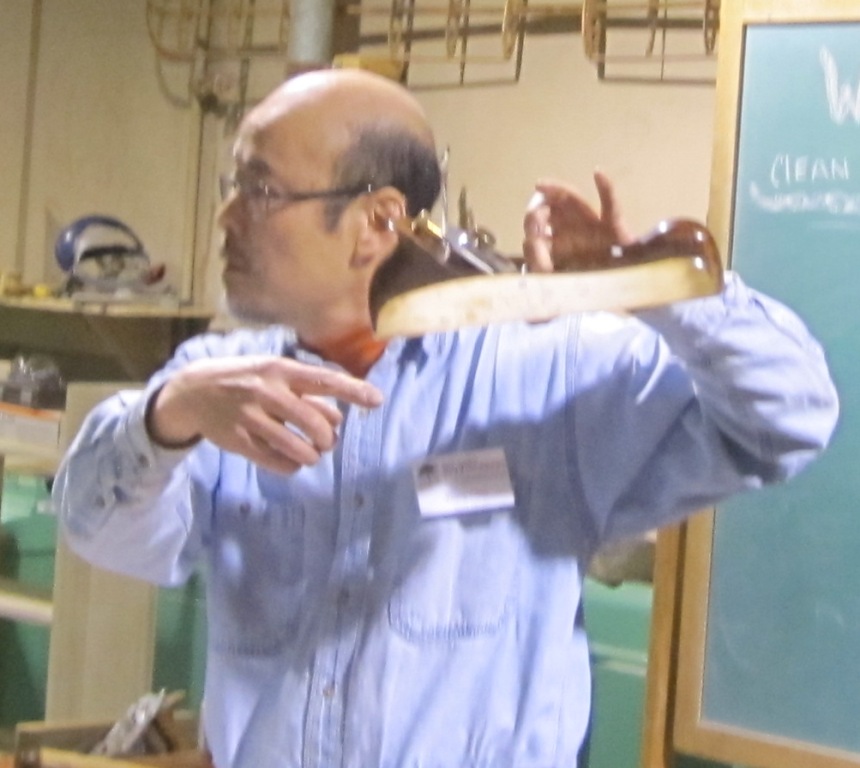
Yeung Chan

Don Naples
After a pizza lunch break, Yeung Chan talked a bit about his history in woodworking, beginning as a child in China where poverty forced him to make tools out of pieces of scrap metal, broken glass, and bamboo. Yeung is an expert in making Chinese furniture and pointed out the he uses blade angles of 55-60 degrees on the typical Asian hardwoods. He does not subscribe to the theory that low angle planes are needed to plane endgrain but that a 45 degree blade angle on a well sharpened blade will work fine. He emphasized the necessity of having the sole flat in both the longitudinal and transverse directions in order for the plane to perform properly. He then went on to talk about the use of scrapers to smooth imperfections in the final finish and the importance of not scraping on one area too long, which would cause a gouge in the surface. Yeung has made his own metal and woodplanes a s well. For the metal plane he began with a piece of brass angle stock for the body and machined most of the parts himself. He brought both a metal block plane and a smoothing plane with him and was justifiably proud of them.
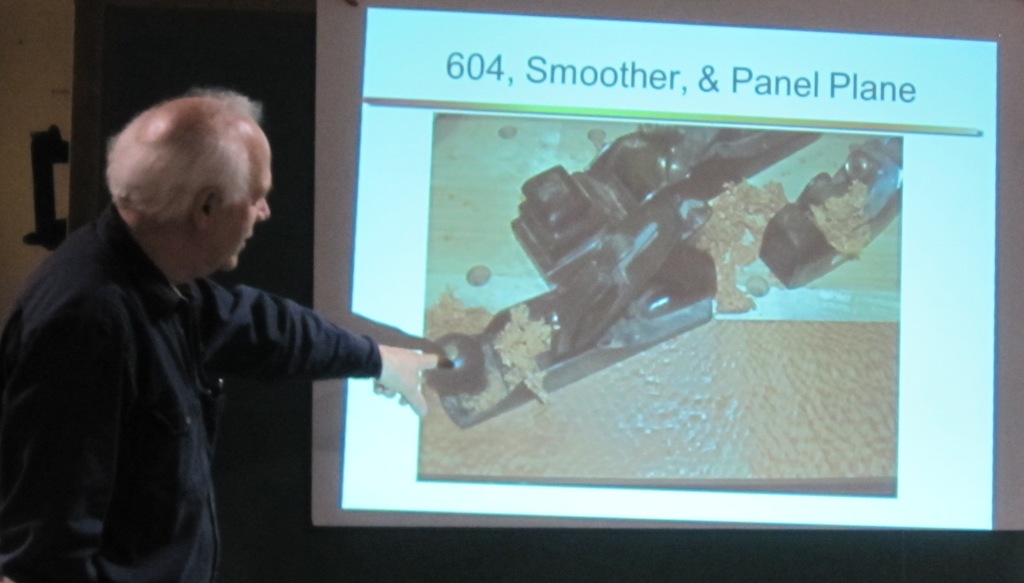
He then turned the floor over to Don Naples who gave an abbreviated version of his expert talk on the history and methodology of producing a sharp edge on a plane blade. Don is the inventor of the Lap-Sharp system so he is obviously partial to it, but he gave a broad overview of all the sharpening systems. The earliest type was the dry stone wheel which continues to be favored by metal workers, but which can overheat a woodworking blade and destroy its temper. This problem is hard to avoid. Similar in design are the low speed wet sharpening systems which avoid the overheating problem by turning the stone wheel slowly through a water bath so that the stool being ground is constantly bathed in water. Next he talked about water stones which are available in natural and synthetic versions. These stones create slurry on the surface of the stone so that the blade does not stick to it. It is critical to keep a close eye on the flatness of these stones as a groove can get worn in during sharpening, leading to a wonky edge. Next he talked about the Scary-sharp system which uses abrasive paper attached to glass. He recommended using alumna abrasive rather than silicon carbide, which breaks down too quickly. He then moved on to diamond stones, which use water as the lubricant. Although these work quite well and remain flat over long periods of time they cannot give a mirror finish to a surface because the finest grits available are too coarse. He recommended the use of ceramic stones to get a finer finish when using these stones. A similar approach using oil-lubricated stones such as Arkansas stone is also employed.
In all cases one should continually monitor the polishing with a 20x magnifier and polish with each grit until the scratch marks of the previous grit are removed. The end result should be an even scratch pattern from edged to edge.
He then demonstrated how to flatten and raise a burr on a card scraper and went on to show how easy it looks to remove whisper thin shavings when it is done by an expert. When Dan Goodman and I tried it on the same wood with the same scraper our results were not nearly so good. Hopefully for us, maybe practice will make perfect.
Following Don's talk the class broke down into small groups, which examined their planes, worked on their planes and made shavings with the advice of the instructors. Jay Perrine put a garage sale plane he had bought in Harold's electrolysis setup to remove rust, Don flattened the back of an eBay purchased plane that I brought, Neal worked with people sharpening plane blades and chisels on his Lap-Sharp. The afternoon buzzed with enthusiastic activity until 3:30 PM when Marcus asked us to clean up and get ready to leave by 4 PM. Evaluations of the day were enthusiastic from all.

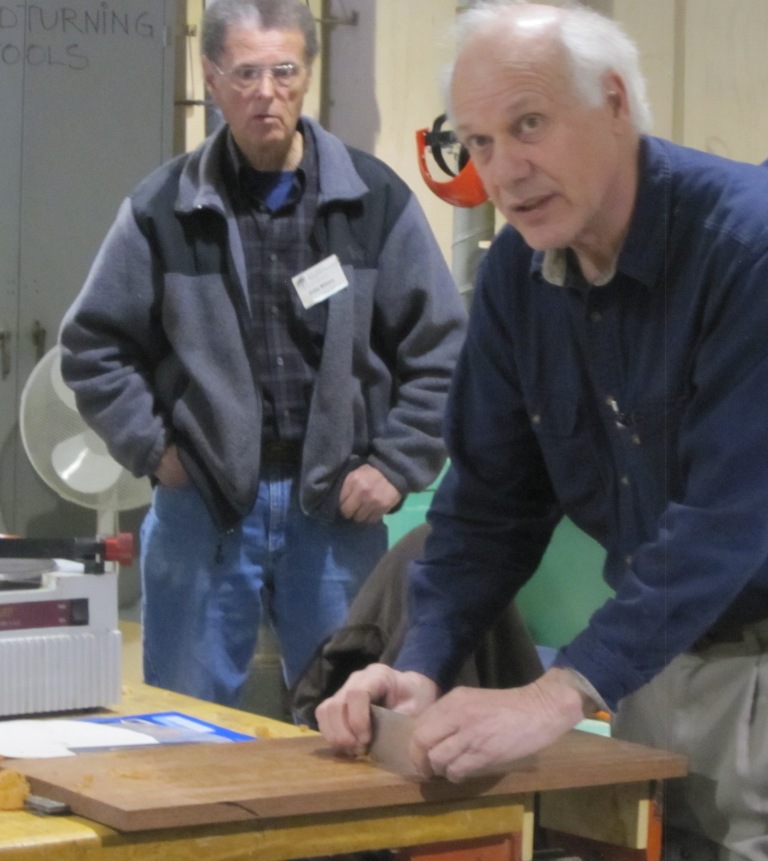
Steve Rosenblum
steve@rosenblums.us